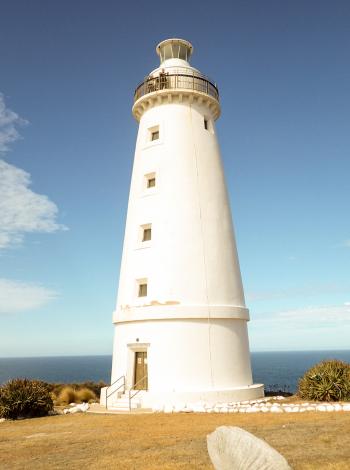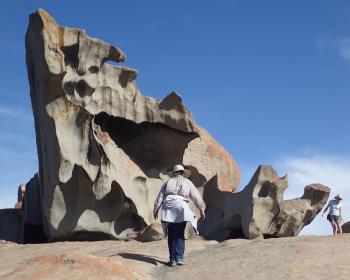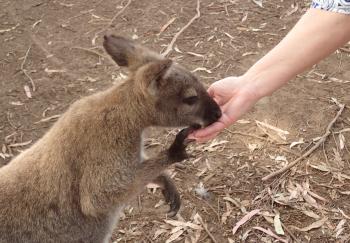Finding more than just marsupials on Australia’s Kangaroo Island
This article appears on page 6 of the February 2019 issue.
Kangaroo Island lies just south of Adelaide, the capital of South Australia. The island is 93 miles wide (east to west) and 35 miles from north to south, and it can be reached by car ferry (from Cape Jervis, on the mainland) or by air (from Adelaide and, from mid-December to the end of January, from Melbourne).
I lived in Sydney in the '70s and part of the '80s, and since that time I've known about Kangaroo Island (KI). Whenever it came up in conversation or I read about it, the island was characterized as a wildlife refuge or a national park, and it does contain areas of wildlife conservation within several national parks, but that's not even half the truth, as my wife, Kathy, and I found out when we finally visited in late March 2018.
Getting settled
Departing Adelaide on a Regional Express (REX) evening flight, it took all of 35 minutes to reach the island. We took a propeller plane, so luggage was limited. (See www.rex.com.au for more information.)
Preferring the independence of driving ourselves, we had booked a rental car from Hertz, and the agent waited for us to deplane. Since we were his only customers at that time — and the gentleman being, well, a true gentleman — he took time to mark up a map for us, explaining what we should and could see and what might not be doable in our little hatchback. With all that good advice, we took off and found our lodgings before nightfall — important because, at dusk and after dark, the risk of running into wildlife is serious.
On the Internet, we'd found Seal Bay Cottages (phone +61 [08] 85596115, www.sealbaycottages.com) and booked a cottage, with our own kitchen, for five nights at AUD138 ($99) per night. Since we'd had no chance to buy groceries on arrival, we ate dinner that first evening in the restaurant near the owners' main house, a short drive from our cabin.
Our cabin was simple but clean, and it had everything we needed. Quite happily, we found ourselves in the middle of nowhere.
In the trees next to our cabin, we located koalas, and the occasional kangaroo hopped across the open fields nearby. Very rambunctious magpies woke us up frequently. What a racket!
The next day we drove to Kings cote to stock up on food and drinks, to look around and to have lunch. I needed some water shoes and found them at the "op shop" (opportunity shop, Australian for thrift shop) there.
Seal Bay
We had picked Seal Bay Cottages because of its central location on the island; the tranquil Bales Beach and the adjacent Seal Bay Conservation Park were both barely 10 minutes away.
At Seal Bay, there was a visitors' center with a gift shop and restrooms, and several options were available for experiencing the seals down on the beach. (For pricing on these options, see www.sealbay.sa.gov.au/plan-your-visit/tour-prices-times.) We opted for the Island Pass (AUD73), which allowed repeated visits to Seal Bay, Kelly Hill Caves, Cape Borda Lightstation and Cape Willoughby Lightstation.
The "seals" at Seal Bay are actually eared sea lions, a fairly rare species (Neophoca cinerea). Of the estimated 12,000 in existence, about 85% live in South Australia and the remaining 15% in Western Australia. They swim out to sea to feed for two or three days at a time, then return to land absolutely exhausted and needing to rest.
The cheaper of the viewing options — from the boardwalk — provides good but fairly distant views across the beach below from high above, but a good telephoto lens might allow for some acceptable pictures, as some of the seals make their way up the hill to rest among the bushes below the boardwalk.
To be right down on the sand with the seals is only possible with a guide. On the 45-minute "Seal Bay Experience Tour" (AUD35.50, or $25.60, per adult), a ranger leads a small group, staying close together, ready to react at a moment's notice in case a seal becomes problematic. During the mating season, tempers flare among competing bulls, and mother seals get protective of their offspring, so the rangers take care to protect both the seals and the visitors.
We did this guided tour twice and highly recommend it. Seeing the behavior of these impressive creatures from up close was fascinating. (The Seal Bay Experience ticket also includes access to the boardwalk, which otherwise costs AUD16 per adult.)
Other excursions
A long drive, mostly on good, paved roads (except for the last few miles), took us to Cape Willoughby, on the far-eastern side of the island, where we visited the lighthouse. The ranger there was very knowledgeable, and we learned a lot about the history and geography of the island, about the old days of seafaring and about the lives of the lighthouse keepers and their families in these remote outposts. It was most enjoyable.
On another day, we took a tour of the Kelly Hill Show Cave, which is just one of the many caves that lie below the island's surface. Then we continued to Flinders Chase National Park, on the far-southwestern end of the island, with a beautiful visitors' center that made a good first impression.
This park offers a great number of activities and would be well worth a few nights' stay in one of the several accommodation options available there, including the possibility of staying in one of three cottages that once were part of the lighthouse keepers' lodgings.
Three highlights of Flinders stood out: The Cape du Couedic lighthouse and its cottages, Admirals Arch and the Remarkable Rocks. These days, the lighthouse is not functioning (except as a museum), but it is well worth a visit.
Admirals Arch is a rock formation that will provide you with great up-close viewing of the long-nosed fur seals typical of the area. A set of paths and steps lead to the viewing platform at the arch, which is a wide opening in the rocks that makes for dramatic pictures of the beach behind.
Perhaps the most amazing feature of Flinders Chase National Park is the Remarkable Rocks, a number of huge boulders that have eroded into, well, remarkable shapes.
Animal encounters
In addition to the wildlife we encountered in natural surroundings, we also enjoyed immensely an outing to the private Kangaroo Island Wildlife Park (www.kiwildlifepark.com), where a multitude of animals can be seen up close in a setting that has the simplicity of a working farm.
At another similarly no-frills facility, the Raptor Domain (www.kangarooislandbirdsofprey.com.au), we had great fun watching the In-Flight Birds of Prey Display, the Venom Pit show (featuring snakes and scorpions) and the Fang-Tastic Reptile Show. Getting up close and personal with two gorgeous lizards on my arm was an unforgettable highlight.
Practicalities
On the island, the distribution of population and services is skewed toward the east side. That's also where most hotels can be found.
On the rest of the island, the accommodations are sparse, mainly consisting of a few modest guest houses, some with cabins, and a number of camping grounds (see www.parks.sa.gov.au).
A few historic locations offer rooms in the style of a B&B, with varying levels of service (see www.parks.sa.gov.au/files/sharedassets/parks/kangaroo-island-heritage-ac...).
Only a few paved roads go across the island, and we found them to be very good. The state of the unpaved ones can vary greatly, from fairly smooth to slightly corrugated to impossibly teeth-rattling. As the agent from Hertz explained, the strict rules found elsewhere about voiding insurance when the renter chooses to drive on unpaved roads can't be applied too strictly on Kangaroo Island. However, there are roads, like the one leading to Cape Borda with its lighthouse, that are, unfortunately, off limits. (Even the locals call that road "very rough.")
Shops are far and few once you get away from Kingscote, where we found one supermarket and one liquor store.
At the end of March, the nights were cool but not unpleasantly so. Day temperatures varied, depending on cloudiness, but were generally warm and never really hot. Even in high summer, around Christmas, the highs don't exceed 75°F.
We don't know just how busy it gets on the island at peak holiday times, like December and January, when Australians take their vacations, but in late March we never experienced what could be called crowds.
There is enough to see on Kangaroo Island to spend at least three nights there, preferably more. Getting around is easy — the distances are manageable and traffic is very light — but not everything is concentrated in one place, so spending just a day trip or planning only an overnight stay is not advisable.
To round out a visit to the region, we'd recommend scheduling a few days in Adelaide, including a tour of the nearby wine country, especially McLaren Vale (www.mclarenvale.info) and Barossa Valley (www.barossa.com/wine).
If you can manage a few days more, consider a one-way rental from Adelaide to Melbourne, taking the coast road and staying overnight in a couple of places along the Great Ocean Road (www.visitgreatoceanroad.org.au).
We spent four nights between leaving Adelaide and flying out of Melbourne, and it was not one hour too many.



